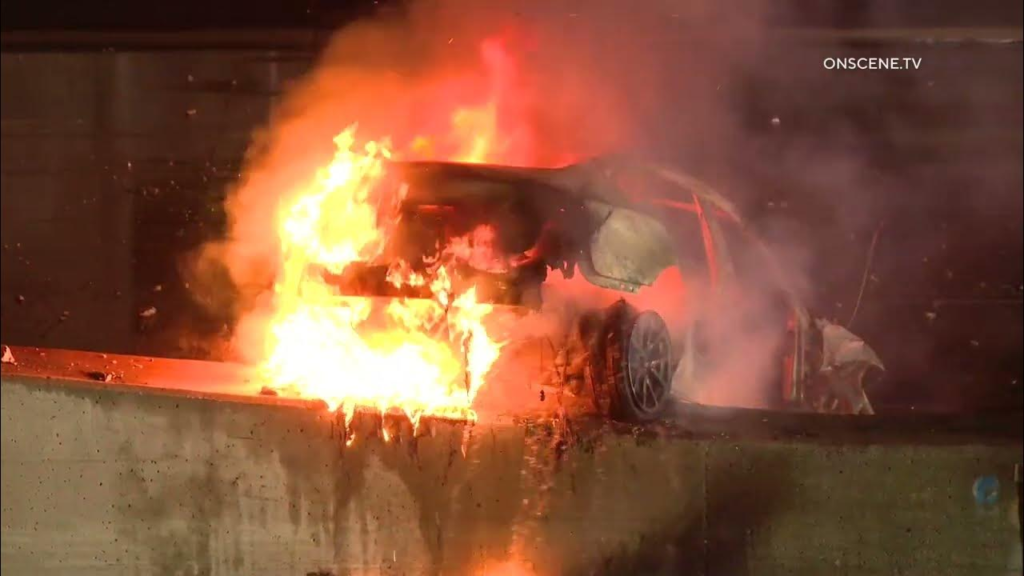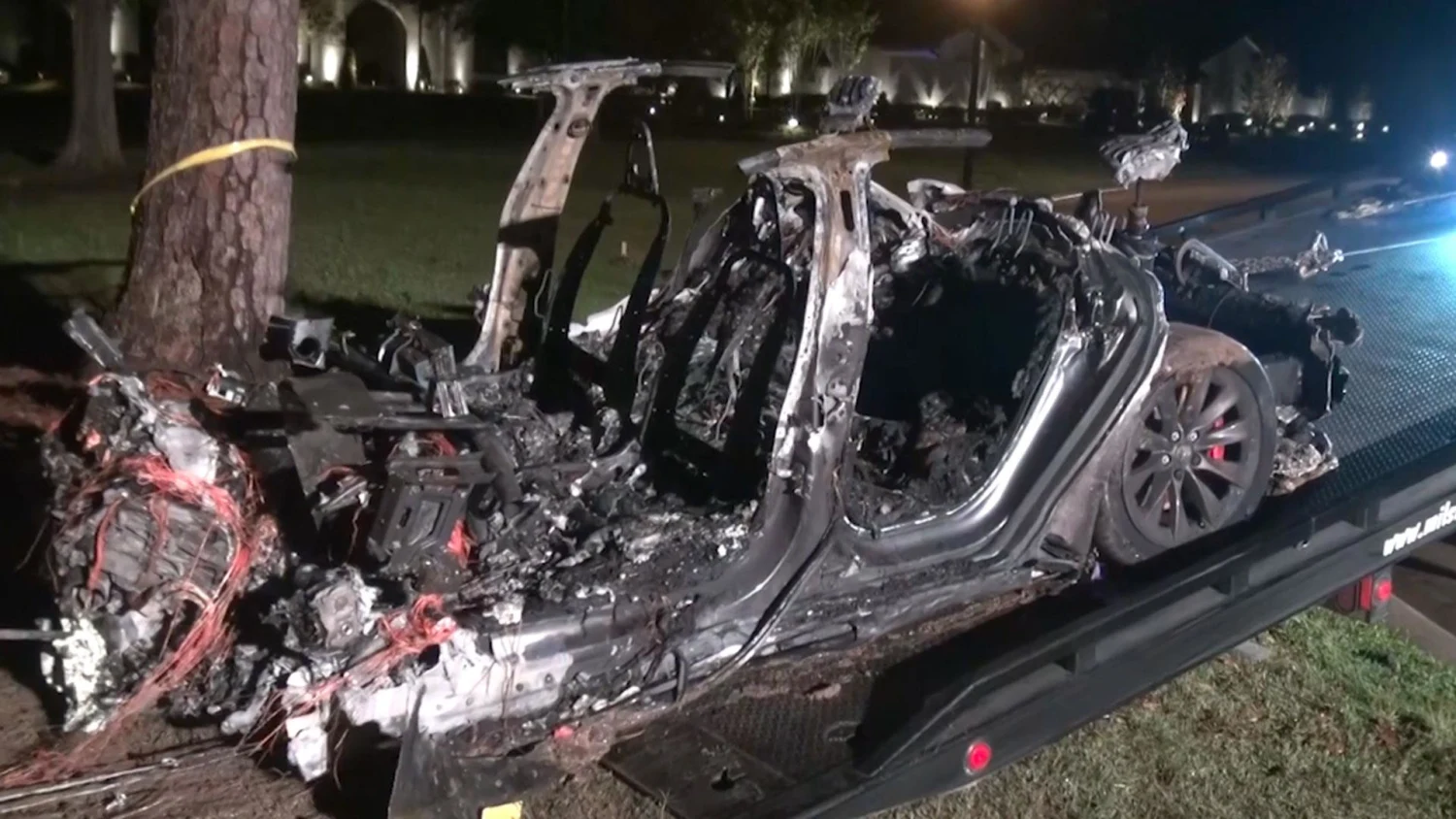A tragic incident occurred when Tesla Car Catches Fire in France, resulting in the deaths of all four passengers inside. The accident has sparked numerous questions and concerns regarding electric vehicle safety.
Investigators are still determining the exact cause of the accident, but initial reports suggest the car struck a road sign and burst into flames. This blog will explore the details of the accident, potential causes, and the broader implications for Tesla and electric vehicle safety.
Details of Tesla Car Catches Fire in France
The fatal crash happened on a Saturday night near the city of Niort, located in western France. According to local authorities, the Tesla vehicle went off the road, hitting a road sign before catching fire. Police Lieutenant Eric Hoarau, who is leading the investigation, noted that there were significant marks on the ground suggesting the car veered off the road at high speed.
The impact with the road sign appears to have played a critical role in the crash, but the investigation is ongoing to confirm whether there were any technical failures or other external factors.
Read : Learning How to Be Human Is the Hardest Thing About Being a Robot: Tesla’s Optimus Robot
One of the major challenges in understanding what happened is the lack of witnesses to the crash. Police arrived at the scene only after the accident had already occurred, making it difficult to piece together the precise sequence of events. Investigators are now relying on evidence from the crash site and forensic analysis to reconstruct the timeline.
The aftermath of the crash was devastating, with all four passengers, including the driver, burned beyond recognition. This raises additional concerns regarding the fire risk associated with electric vehicles, particularly with Tesla’s lithium-ion battery technology. While Tesla vehicles are designed with multiple safety features, the fire in this case was so intense that it left little room for escape or rescue.
Potential Causes and Investigations
At this point, investigators are looking into several potential factors that could have contributed to the accident. One possibility is driver error or loss of control, as indicated by the marks on the road.
High speeds combined with a sharp turn or obstacle could have caused the driver to lose control of the vehicle, leading to the crash. However, another area of focus for investigators is the role of the car’s autopilot or driver-assist system, which is installed in Tesla vehicles.

Tesla’s autopilot system has come under scrutiny in the past due to a number of high-profile accidents. Although the company emphasizes that autopilot is not a fully autonomous driving feature and requires driver supervision, there have been cases where drivers appeared to rely too heavily on the technology.
Investigators will be reviewing data logs from the vehicle to determine whether the autopilot system was activated at the time of the crash and if it played a role.
Another key issue is the intensity of the fire. Electric vehicles, especially those powered by lithium-ion batteries like Teslas, carry unique fire risks. These batteries can ignite when damaged, and once they catch fire, they are notoriously difficult to extinguish.
The high energy density of the batteries, while essential for providing long-range driving capability, also makes them susceptible to thermal runaway, a process where heat builds up and causes the battery to combust.
In this particular incident, the fire spread so quickly and with such intensity that the passengers had no time to escape. Investigators will examine the state of the battery pack to see if it was damaged in the crash and if that led to the fire. Understanding the chain of events is crucial for improving safety standards and preventing similar tragedies in the future.
Broader Implications for Tesla and Electric Vehicle Safety
This accident is not the first to involve a Tesla vehicle catching fire after a crash, and it raises broader concerns about electric vehicle safety. Tesla has long positioned itself as a leader in electric vehicle technology, with a strong focus on safety.
The company’s cars are equipped with a range of features designed to prevent accidents, including advanced driver assistance systems and a unique design that positions the heavy battery pack under the floor for better stability.
However, as electric vehicles become more common on the roads, accidents like these highlight the need for constant vigilance and improvement in safety measures.
Lithium-ion batteries, while efficient, have known safety issues that must be carefully managed. The process of thermal runaway, which can occur when the battery is punctured or damaged in a crash, remains a significant risk. Once a fire starts, it can be extremely difficult for emergency responders to put out, leading to tragic outcomes like in this case.

Tesla has made strides in improving battery safety, including adding software that monitors battery health and taking steps to make the cells more resilient to damage. However, the nature of this crash shows that even with these precautions, accidents involving high-speed impacts can still result in catastrophic fires.
The question now is whether Tesla, and the electric vehicle industry more broadly, can address these risks effectively enough to prevent future tragedies.
Beyond the immediate tragedy, this crash could have a broader impact on the public’s perception of electric vehicle safety. As more people adopt electric cars, it is critical to ensure that they are not only efficient but also safe in all driving conditions.
Incidents like this one could raise concerns among potential buyers, especially those who may already be hesitant to make the switch from gasoline-powered vehicles. Tesla and other electric vehicle manufacturers will need to continue improving their safety features, and regulatory agencies may introduce stricter guidelines to ensure that electric vehicles are as safe as possible.
The tragic crash in France involving a Tesla vehicle that resulted in the deaths of four people is a sobering reminder of the risks associated with electric vehicles. While the exact cause of the accident is still under investigation, the role of the car’s autopilot system, the speed at which the vehicle was traveling, and the possibility of a battery fire are all areas of concern.
As electric vehicles become increasingly prevalent, ensuring their safety will be paramount to preventing further loss of life. Tesla, in particular, faces the challenge of addressing these safety concerns while maintaining its position as a leader in the electric vehicle industry.

